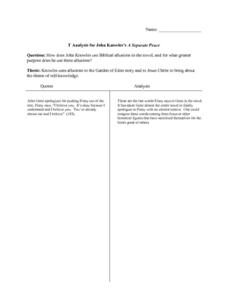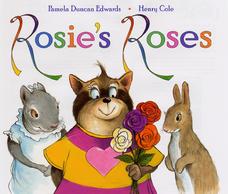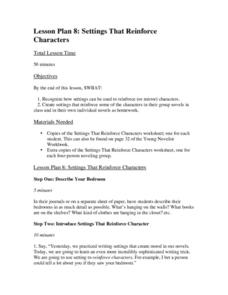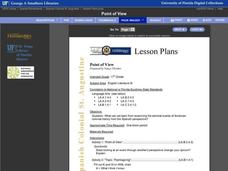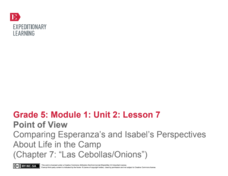Curated OER
A Separate Peace: Chapter 9 Reading And Study Guide
Pupils define 3 vocabulary words, define 1 literary term, and respond to 10 short-answer questions pertaining to chapter 9 of A Separate Peace by John Knowles. These activities are designed to help them better understand the novel and...
Curated OER
A Separate Peace: Chapter 11 Reading and Study Guide
To better comprehend the novel, A Separate Peace by John Knowles, learners define 3 vocabulary words, define 1 literary term, and respond to 10 short-answer questions. This resource refers only to Chapter 13 of the book.
Curated OER
A Separate Peace - T Analysis
Reading A Separate Peace? Readers analyze important quotes that appear in John Knowle's classic novel using the provided graphic organizer. Learners record a passage and provide an accompanying analysis for each entry. Consider having...
Curated OER
Rosie's Roses
Based on the alliterative book Rosie's Roses by Pamela Duncan Edwards, here is a resource to reinforce phonics and alliteration for younger readers. Several suggested activities would easily adapt to other books. Sparse procedural details.
Curated OER
A Modest Proposal: Irony Made Understandable with Rock and Roll
Who doesn't love music? Poems and songs will engage your high school class in a discussion about irony. Use songs like "Rockin' in the Free World" or "Born in the U.S.A." to illustrate the ironic point of view. Print the lyrics so...
Curated OER
Bridge to Terabithia
Students explore scenes from Katherine Paterson's book, Bridge to Terabithia. In this visualization activity, students listen to the story read aloud. The students then choose words and phrases that paint a picture in their heads....
Curated OER
Digging Deep for Figurative Language (Hyperbole)
What are hyperboles? Examine the attributes of hyperboles with your high school classes. Pupils read selected poems and prose selections that feature hyperboles and discuss their functions in each work of literature. Specific poems and...
Curated OER
Where
Kindergartners identify where a story takes place. For this literature lesson, learners take a picture walk and discuss how pictures can provide clues to the location of the story. They then illustrate where a new story of their own...
Curated OER
Where and When
Use the pictures from Knuffle Bunny to determine setting with your class. Model your visualization and thinking process, asking questions to help your listeners determine time and place. After reading this story, go through other books...
Curated OER
Two Settings
Learners respond to the text Riding Freedom. They will compare and contrast two settings by filling in a graphic organizer. They explore different settings, discuss the reasons why settings change, and draw conclusions using descriptive...
Curated OER
Color My World Grey and Blue
Can colors help to convey a mood in writing? Explore this question with your class using the songs "Grey Street" by the Dave Matthews Band and "Blu is a Mood" by Blu Cantrell. After analyzing the effect of the color words in these songs...
Curated OER
Identifying Personification in Poetry
Improve your young poets' descriptive writing with this lesson plan on personification. A SMART board and PowerPoint presentation guide your class through the process of identifying human qualities attributed to various non-human...
Curated OER
Tortoise and Hare Races
Practice basic map skills with the story of The Tortoise and the Hare. After listening to the story, class members create a map that indicates the starting line, the path the animals took, where they stopped to rest, and the finish line....
Curated OER
What Makes a Novel a Novel?
They always say to write what you know. This approach is used to get middle schoolers prepared to write novels of their own. Using a favorite book as a model, potential novelists respond to prompts that ask about characters, plot, main...
Curated OER
Lesson 8: Settings that Reinforce Characters
The best way to be a good writer is to read good writing. Learners read and discuss an excerpt from a book that will help them comprehend the relationship between setting and character. They will use what they've gleaned from discussion...
Curated OER
Compare and Contrast Two Settings in One Text
Look for the signal words! Scholars get both instruction and practice comparing and contrasting. Although it is completely scripted, it can also serve as a detailed outline. Demonstrate this as you read a passage (included) and search...
Curated OER
Point of View
Class members examine depictions of Thanksgiving in various mediums and discuss how point of view influences the composition and presentation of the work. While the focus here is on important events in American history as seen from the...
Bantam Books
The Tempest: Think-Aloud Annotation
It can be difficult to refer back to a text when analyzing it, so annotation is a great tool for kids to track what they are reading. A thorough and well-organized lesson guides learners through the process of annotating William...
EngageNY
Point of View: Comparing Esperanza's and Isabel's Perspectives About Life in the Camp (Chapter 7: "Las Cebollas/Onions")
Explore point of view and more with a Common Core-designed instructional activity. Learners experience different points of view by representing one of two characters from Esperanza Rising during a partner discussion. They must use...
Maine Content Literacy Project
Dramatic Structure of the Short Story
The second lesson in a series of fourteen, this plan takes the short story basics a step further. Learners complete a quiz about the story from the previous day, discuss the text, learn about Anton Chekhov, and work in groups to begin...
Maine Content Literacy Project
Introduction to the Short Story
How should pupils read short stories? Set them up for this unit with an introductory lesson that goes over the main characteristics of a short story and starts learners off reading their first short story of the unit. In order to get a...
Maine Content Literacy Project
Introduction to Ernest Hemingway
What is a white elephant, and what does it have to do with Ernest Hemingway? Study "Hills Like White Elephants" in-depth by following the procedures outlined in this instructional activity, the fifth in a series of fourteen. Learners...
University of Detroit Mercy
Word Basics
Are you using or considering using Microsoft Word for Mac 2011? If so, check out this tutorial that introduces some of the tasks and features that you can use in all your documents. Learn how to create a new document, navigate through a...
Curated OER
Lesson: Beyond First Impressions
Just like the colors and techniques used to create a vivid image, learners will use exceptional language to create vivid stories. They examine the techniques used to tell a visual story in the painting, Road to Santa Fe. They then use...
Other popular searches
- Elements of Art
- Elements of Art Worksheets
- Elementary Art Elements
- Art Elements Space
- Teaching Elements of Art
- Art Elements of Design
- Five Elements of Art
- Elements of Art Value
- Art Elements and Principles
- Fundamental Elements of Art
- Elements of Art Line
- Basic Art Elements




